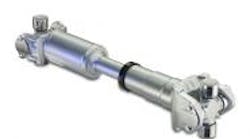“Drivelines are at once very simple yet very complex components. They are very important in terms of vehicle reliability. It’s one of those components that often goes largely unnoticed but is oftentimes very critical to vehicle uptime and operation.” –Karl Mayer, ArvinMeritor’s director-product line management for drivelines
Let’s face it: drivelines aren’t the sexiest component on a big rig. Heck, they aren’t even visible, unless you crawl under a Class 8 truck and look up underneath at the chassis.
You can hear the big growl of a diesel; you physically interact with the transmission, either manually changing the gears or at least moving the shift lever from ‘P’ to ‘D’. Tires, wheel hubs, axles, not to mention cab styles, all get their day in the sun, so to speak. But a driveline? C’mon, man – it’s a couple of tubes, a u-joint, and yokes. Not much to write home about, as the saying goes.
Yet without the driveline, the truck doesn’t move, for it connects the transmission to the axles. No driveline means no torque reaches the axles, which turn the wheels on the asphalt. To badly butcher an old phrase, pop a driveline and your trucking goose is cooked; you won’t be limping anywhere without it.
So I found it more than appropriate to get immersed in driveline engineering for a day, courtesy of ArvinMeritor. Hosted at the company’s 115,000 square foot Research, Development, and Validation (RDV) center outside Detroit, this “deep dive” into drivelines (a favorite phrase of legendary and much beloved P.R. great D. Mike Pennington) tried to put this often “out of sight, out of mind” component into more proper perspective within the operation of a Class 8 trailer.
[You can watch Karl Mayer, ArvinMeritor’s director-product line management for drivelines, provide a quick overview of the location and function of a Class 8 driveline in the clip below.]
“What does a driveline do? It transmits the torque from the truck’s transmission thru various speed ranges and various angles to the axles – while at the same time compensating for changes in length,” explained Thomas Sanko, ArvinMeritor’s product manager-drivelines.
“A lot of times, the focus is on the horsepower and torque transmitted from the engine to the transmission, while the driveline’s role in getting that torque from the transmission to the axles is ignored. It seems a simple function, but when you think about what the driveline has to do, you soon see it’s a complicated part.”
First, think about angles: a driveline operates at an angle of 6 degrees or less, not in a straight line. That’s because the engine and transmission are mounted higher off the ground in relation to the axles.
Next, you’ve got to remember that drivelines spin awful fast, yet at the same time are completely exposed to the “environmental” conditions (for lack of a better term) under a truck.
That means salt spray in the winter, dust in the summer, bits of rubber, metal, rock, and goodness knows what else kicked up as the truck travels down the highway at 65 mph. You ever get hit by a small piece of rubber going 65 mph? Ouch! Yet the driveline must be able to withstand all that punishment and still keep turning.
There’s all sorts of funky terms for the many parts that make up a driveline, too, like “spline,” “end yoke,” “bearing stub,” “trunnion,” and “welch plug.”
And ArvinMeritor’s engineers put all of these parts through man-made hell at the company’s RVD center: a building comprised of 18 labs testing everything from (of course) drivelines to axles, brakes, suspension components, you name it, for commerical and military vehicles alike.
Five tests in all are conducted on driveline parts. They include: an “ultimate strength” test that twists a complete driveline until it breaks, to see how much force it can withstand; a durability test spins u-joints at 3,000 rpms evaluate its design life; well past 1 million miles of truck operation; and the infamous “environmental box” test (at right) that subjects components to minus 30 degrees Fahrenheit up to 118 degree F to see how they’ll hold up.
Anthony “Tony” Lentini, ArvinMeritor’s principal engineer for drivelines, added that company even uses actual sand from Arizona blown into a working driveline to see how it impacts the parts. “The grain size of Arizona sand is far more damaging; it creates a lot more stress on the components,” he explained.
It’s all part of an effort to make sure this critical component can withstand whatever the world of trucking throws at it, noted Mayer. “Durability and reliability is everything when it comes to drivelines,” he said.



